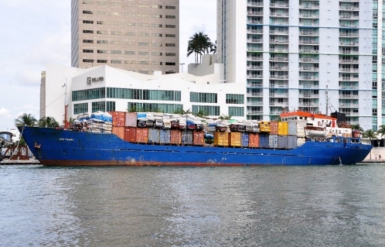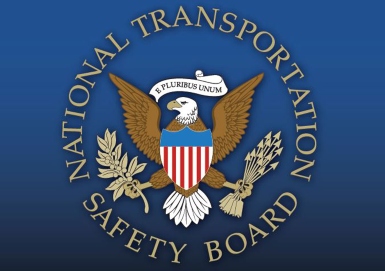 The National Transportation Safety Board (NTSB) has released an investigation report on an incident where the towed cargo vessel Carib Trader II flooded and sunk in March 2022 in the Bahamas.
The National Transportation Safety Board (NTSB) has released an investigation report on an incident where the towed cargo vessel Carib Trader II flooded and sunk in March 2022 in the Bahamas.
The Incident
On March 6, 2022, about 1620 local time, near the Magallanes Bank, about 25 miles northwest of Santo Domingo Cay, Bahamas, the uncrewed general cargo vessel Carib Trader II took on water and sank while being towed by the towing vessel Capt. Beau, which had five crewmembers aboard. A small debris field was reported. There were no injuries. Damage to the vessel was estimated at $752,700.
What happened
On March 3, 2022, the 107.7-foot-long towing vessel Capt. Beau began a dead ship tow of the uncrewed 273.9-foot-long containership Carib Trader II out of the Port of Miami, bound for Gonaïves, Haiti, a 4-day transit. Carib Trader II was being relocated to a Haiti shipyard for repairs. The vessel had been detained in Miami by the US Coast Guard since November 2020 due to numerous safety, security, and environmental deficiencies.
In February 2022, a flag state surveyor and Coast Guard inspectors examined the vessel prior to approving the dead ship tow from Miami to Haiti. They found the above-water hull, decks, and weather and watertight closures to be satisfactory. Because the vessel was moored, the underwater hull was not examined.
The Carib Trader II was towed astern of the Capt. Beau on a 2-inch wire rope with approximately 1,000 feet extended, which was connected to a 1 3/4-inch Spectra bridle. The bridle lines were connected to 2-inch chain used as chafing gear, run through the Carib Trader II’s chocks, and connected to 1 3/4-inch wires, which were wrapped around the port and starboard mooring bits.
According to a tow plan provided by the vessel manager and approved by the Coast Guard, the tow was not to occur if winds were forecasted to exceed 25 knots sustained or the sea state or swells were expected to be greater than 8–10 feet. The midnight logbook entry for March 6 read that the tow was making 4.2 knots, with winds 24–30 knots and seas 7–9 feet. At 0035, the mate on watch said he heard a “bang” and the Capt. Beau’s speed increased, which he believed indicated that the tow had broken free. The mate woke the captain, who took the helm. The engineer, mate, and able seaman on watch reeled in the towing wire and found that both legs of the Spectra bridle had parted.
At 0141, as the Capt. Beau attempted to recover the Carib Trader II, the crew found that straps used to secure the port anchor for the tow had parted, and the vessel’s port anchor chain had payed out. The captain also noticed that the Carib Trader II was riding lower at the stern. The crew reattached the tow line to what was left of the port leg of the Spectra bridle and, by 0400, took the Carib Trader II back under tow at a slow speed, with a plan to reevaluate the situation at daylight.
After sunrise, the captain thought the ship was trimmed by the stern more than it had been when they recovered the tow several hours earlier. At 0720, the mate boarded the Carib Trader II and found the engine room flooded, with water above the main engine. The mate was not able to identify the source of the flooding.
The captain directed the mate to find the pump—a Predator 212cc gasoline-engine semitrash water pump with 2-inch hoses—that had been prestaged on board for the tow and begin dewatering. The mate brought the pump down to the engine room, rigged the hoses, and began pumping water overboard. The mate checked the engine room, pump, and hoses about every 15 minutes. At 1100, the mate reported to the captain that the pump was not keeping up with the flooding.
The captain told investigators that, by 1500, it became obvious that the Carib Trader II would sink. The Carib Trader II started listing to starboard and, about 1520, the mate departed the cargo vessel. The captain did not think the crew would be able to disconnect the tow before the Carib Trader II sank, so all of the tow wire was payed out to get the Capt. Beau as far away from the towed vessel as possible before the engineer cut the wire.
The Capt. Beau remained nearby while the Carib Trader II continued to sink. At 1620, the Carib Trader II sank stern first in a water depth of about 3,300 feet, taking the towing wire and bridle with it and leaving a small debris field. After the sinking, the Capt. Beau returned to Miami.
Analysis
The tow line bridle to the Carib Trader II parted in winds and seas that were near the maximum allowed in the tow plan. The Capt. Beau crew found that the Carib Trader II’s port anchor chain had payed out and the ship was riding lower at the stern. The increased drag from the tow’s greater draft and a trailing anchor, combined with dynamic loading of the towline assembly in the 7–9-foot seas and 24–30-knot winds, would have increased forces on the bridle.
The Carib Trader II, which had a history of substandard care and maintenance, had been in layup for 2 years. The inspection history of the vessel suggests the Carib Trader II was in poor condition. After boarding the vessel, the mate found the engine room flooding, and, although he attempted to dewater with a portable pump prestaged for the dead ship tow, the pump was not able to keep up with the flooding. Because the engine room was found to be flooding rapidly, it is likely that the source of the flooding was below the waterline.
Probable cause
NTSB determined that the probable cause of the flooding and subsequent sinking of the Carib Trader II while under dead ship tow was the uncontrolled flooding of the engine room from an undetermined location below the waterline.
Read the full report here:NTSB-Flooding-and-Sinking-of-the-Towed-Cargo-Vessel-Carib-Trader-II-2024_01


